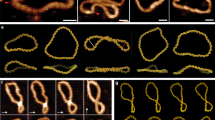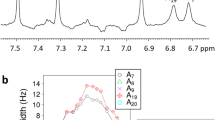Abstract
Recently, a new structure called Z-DNA has been proposed for alternating poly(dG-dC)·poly(dG-dC) sequences based on crystallographic analysis of the hexanucleotide1. The Z-form is a left-handed double helix containing 12 base pairs per turn. In contrast, the Watson–Crick B-form helix is thought to have 10.4 pairs per turn of right-handed helix2,3,8. A cooperative, salt-induced conformational transition has been observed in poly(dG-dC)·poIy(dG-dC)4, which has been interpreted as being between the B-form (low salt) and the Z-form (high salt)1. We now analyse the possibility that such transitions could occur in susceptible sequences in physiological conditions as a consequence of the torsional stresses imposed by superhelicity. As in vivo DNA commonly occurs in a negatively supercoiled, hence underwound, state, these transitions could serve important biological functions. Both thermodynamic and statistical mechanical theories of stress-induced two-state transitions have been developed previously5,6. Here we apply these theories to transitions between the B-form and the Z-form in regions of appropriate base sequence. Assuming that the unstressed duplex is entirely B-form, we show that when the molecule is constrained to be underwound, susceptible regions may transform to the Z-form, thereby absorbing most of the torsional deformation. Interestingly, this transition is relatively independent of temperature.
This is a preview of subscription content, access via your institution
Access options
Subscribe to this journal
Receive 51 print issues and online access
$199.00 per year
only $3.90 per issue
Buy this article
- Purchase on Springer Link
- Instant access to full article PDF
Prices may be subject to local taxes which are calculated during checkout
Similar content being viewed by others
References
Wang, A. et al. Nature 282, 680–686 (1979).
Wang, J. Proc. natn. Acad. Sci. U.S.A. 76, 200–204 (1979).
Levitt, M. Proc. natn. Acad. Sci. U.S.A. 75, 640–644 (1978).
Pohl, F. & Jovin, T. J. molec. Biol. 67, 375–396 (1972).
Benham, C. Proc. natn. Acad. Sci. U.S.A. 76, 3870–3874 (1979).
Benham, C. J. chem. Phys. 72, 3633–3639 (1980).
Barkley, M. & Zimm, B. J. chem. Phys. 70, 2991–3007 (1979).
Crick, F., Wang, F. & Bauer, W. J. molec. Biol. 129, 449–461 (1979).
Author information
Authors and Affiliations
Rights and permissions
About this article
Cite this article
Benham, C. Theoretical analysis of transitions between B- and Z-conformations in torsionally stressed DNA. Nature 286, 637–638 (1980). https://doi.org/10.1038/286637a0
Received:
Accepted:
Issue Date:
DOI: https://doi.org/10.1038/286637a0
This article is cited by
-
Ising model forB-Z transition in supercoiled DNA
Bulletin of Mathematical Biology (1992)
-
Energetics of superhelicity and of B-Z transitions in superhelical DNA
Cell Biophysics (1987)
Comments
By submitting a comment you agree to abide by our Terms and Community Guidelines. If you find something abusive or that does not comply with our terms or guidelines please flag it as inappropriate.



